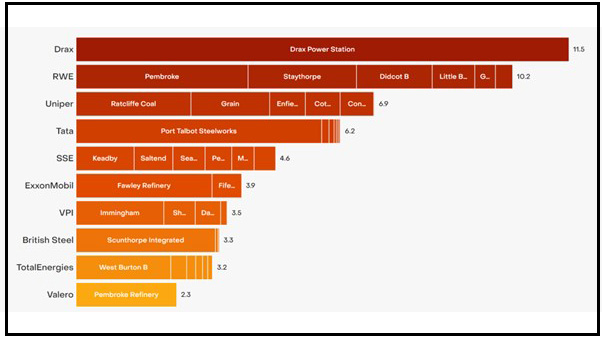UPDATED 1 Sept: The EI library in London is temporarily closed to the public, as a precautionary measure in light of the ongoing COVID-19 situation. The Knowledge Service will still be answering email queries via email , or via live chats during working hours (09:15-17:00 GMT). Our e-library is always open for members here: eLibrary , for full-text access to over 200 e-books and millions of articles. Thank you for your patience.
New Energy World™
New Energy World™ embraces the whole energy industry as it connects and converges to address the decarbonisation challenge. It covers progress being made across the industry, from the dynamics under way to reduce emissions in oil and gas, through improvements to the efficiency of energy conversion and use, to cutting-edge initiatives in renewable and low-carbon technologies.
A new report from think tank Ember finds the Drax power station is ‘by far the largest emitter of CO2 in the UK’, although steelworks and gas power plants are also listed.
A new report from Ember suggests that biomass burning, steelworks and gas power are the top UK carbon emitters, with the Drax power plant the largest single source of carbon emissions in the UK (see Fig 1). According to Ember, burning wood for electricity the Drax plant emitted 11.5mn tonnes of CO2 in 2023, equivalent to 2.9% of total UK territorial emissions. That was more CO2 than the next four power stations combined, and over four times the emissions of the UK’s remaining coal power plant, Ratcliffe-on-Soar (2.7mn tonnes of CO2e), claims the study.

Fig 1: Top 10 emitters by company, in mn tCO2e, 2023 (direct emissions only, excluding the sale of fossil fuels or the use of electricity)
Source: UK Emissions Trading Scheme Reporting, Drax – annual report; Ember analysis
Other large industrial plants also feature in Ember’s top emitters list, with large metalworks sites such as at Port Talbot and Scunthorpe among the top 10 largest single sources of emissions, as well as three of the six large UK refineries – Fawley, Pembroke and Stanlow. In total, the refineries and steelworks plants in the UK largest emitters tables emit the equivalent of 5% of total UK emissions, compared to 12% from the power sector, suggests the study.
On a more positive note, some of the largest emitters have existing and planned low-carbon investments, notes Ember. Electrification is one promising route available to decarbonise large industries such as steelworks; for example, in early 2024 an electric arc furnace was granted planning permission at Teesside steelworks. Other technologies also the subject of research funding include hydrogen or carbon capture, although Ember suggests the latter ‘remains a speculative decarbonisation route… and is not expected to change the top emitters list in the short term’.
The think tank also notes that the closure of the Ratcliffe coal power plant in September 2024 will impact the ranking in the top 10 table in future years.
Ember reports that EU and UK emissions trading schemes do not require wood-burning power plants to report their emissions, as they assume the emissions are offset by forest regrowth. (However, direct emissions are reported by Drax itself.) For that reason, biomass power plants in the UK have a sustainability classification meaning that they are eligible for public subsidies, comments Ember, which estimates that in 2023 Drax received £539mn in subsidies, the combination of ROCs earnings and contracts for difference (CfD) payments.
In its report, Ember goes on to suggest that ‘serious concerns remain about the overall emissions of using biomass for power generation’. It cites a 2021 article from the European Academies Sciences Advisory Council which states that using woody biomass for power ‘is not effective in mitigating climate change and may even increase the risk of dangerous climate change’.
Ember also criticises the UK large biomass power sector for being import-dependent. It reports that the UK produced only 0.3mn tonnes of wood pellets in 2023, ‘meaning that Drax power station consumes just under 20 times the UK’s domestic pellet production annually’.
Meanwhile, an Ofgem investigation concluded in late August 2024 that there was ‘an absence of adequate data governance and controls in place’ which contributed to Drax misreporting environmental data relating to the Renewables Obligations (RO) scheme and other related matters for the compliance period 1 April 2021 to 31 March 2022 (CP20). As a result, Drax has agreed to pay £25mn into Ofgem’s Voluntary Redress Fund and is to re-report its CP20 annual profiling submission for Canadian consignments of feedstock to its plant.
However, Ofgem reports that during its investigation it did not find any evidence to suggest that Drax had been issued with Renewables Obligations Certificates (ROCs) incorrectly. Nor did the investigation find any evidence suggesting that Drax does not meet the government’s threshold that a minimum of 70% of biomass must come from sustainable sources in order to receive scheme funding.
